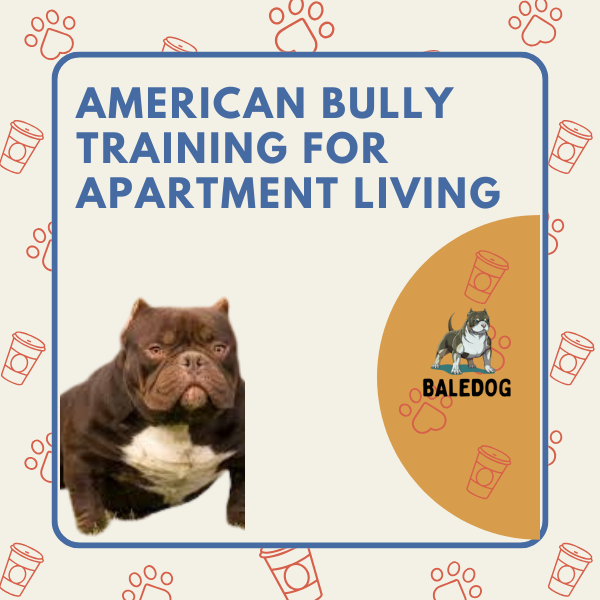Let’s face it—American Bullies are some of the most adorable, loving, and strong dogs out there. But with their muscular build and high energy levels, you might be wondering: “Can they actually live comfortably in an apartment?” The good news is, yes! With the right training and a bit of planning, an American Bully can thrive in apartment living. But it’s going to take some extra care, patience, and knowledge to make sure your pup is as happy as possible in a smaller space.

In this article, we’re going to dive deep into everything you need to know about training an American Bully for apartment living—from dealing with their high energy to making sure they stay calm and happy in confined spaces. Whether you’re thinking about getting an American Bully or already have one, this guide will set you on the right path.
Why Choose an American Bully for Apartment Living?
You might be surprised to hear that the American Bully breed can actually do well in apartments—if you’re prepared for their needs. Despite their intimidating, tough exterior, they’re known to be affectionate and friendly dogs. Bullies tend to be great companions, very loyal to their families, and can adjust well to indoor life if given enough stimulation and exercise. The key is meeting their physical and mental needs in a way that doesn’t require a yard or huge space.
But even though they’re great apartment dogs, training is super important. These dogs can get bored quickly, and without the right guidance, they might get destructive or noisy. So, let’s break down some essential tips for living happily in a smaller space with an American Bully.
1. Start with Basic Obedience Training
If you’re living in an apartment, one of the most important things to teach your American Bully is basic obedience training. This isn’t just for fun—it’s necessary for keeping your pup well-behaved in a confined space.
Essential Commands to Focus On:
- Sit, Stay, Come: These basic commands will keep your Bully under control in situations where you need them to calm down or focus.
- Leave It: If your dog tries to chew on something they shouldn’t (like your shoes or furniture), teaching this command is key to preventing destruction.
- Quiet: This command will help when your Bully gets a little too vocal, which is common for Bullies who tend to bark when bored or excited.
Start these training sessions early, and keep them short and fun—about 10-15 minutes per session. Use positive reinforcement with treats and praise. Remember, consistency is key when it comes to teaching commands.
2. Exercise and Mental Stimulation
One of the biggest challenges of having an American Bully in an apartment is managing their high energy levels. These dogs were originally bred to be muscular and strong, so they’ve got a lot of energy to burn. Without enough exercise, they can get anxious, frustrated, and even destructive.
Luckily, there are a few ways you can keep your American Bully physically and mentally stimulated, even in a small space.
A. Daily Walks and Playtime
Even if you don’t have a yard, your American Bully still needs daily walks to burn off that excess energy. Aim for at least 30 minutes to an hour of walking each day. You can break it up into two shorter walks if necessary—one in the morning and another in the evening.
Aside from walks, Bullies love interactive play like fetch or tug-of-war. These activities will give them both physical and mental stimulation, helping to tire them out.
B. Indoor Activities
If you’re unable to get outside, there are plenty of fun indoor activities you can do to keep your dog busy. Set up an obstacle course in your apartment with chairs, pillows, or other items. You can even teach your Bully new tricks to keep their brain active. Puzzle toys that hide treats or kibble are great for keeping their minds sharp and distracted from destructive behaviors.
3. Managing Behavior in Small Spaces
Apartment living means you’ll have limited space, so managing your American Bully’s behavior is crucial. You want your dog to feel comfortable but also be aware of the fact that they need to follow certain rules in a smaller, shared environment.
A. Crate Training
Crate training is a game-changer when it comes to apartment living. Crates provide a safe, cozy space for your Bully when you need them to settle down, whether you’re gone for a few hours or just need them to relax while you work from home.
- How to Get Started: Introduce the crate as a positive space by placing their favorite toys, a comfy blanket, and maybe a treat inside. Don’t use the crate as punishment; instead, make it their personal “den” where they can relax.
- Duration: At first, limit the amount of time your Bully spends in the crate. Gradually increase the time as they become more comfortable with it. You want them to see it as a chill place, not a prison.
B. Noise and Barking Control
American Bullies are naturally alert and protective, which can sometimes translate to excessive barking, especially in an apartment where noises from neighbors or passersby can trigger them. One of the first things to teach them is the quiet command. Consistently use it whenever they bark unnecessarily, and reward them for stopping.
Also, try to desensitize your Bully to the sounds that might trigger barking. Play recordings of doorbells, traffic sounds, or neighbor noises while you work with your dog on staying calm.
C. Setting Boundaries in Small Spaces
In an apartment, it’s important to establish clear boundaries. Some dogs tend to get a bit too comfortable and start to claim the whole apartment as theirs—this can lead to unwanted behaviors like resource guarding or territorial barking.
Teach your Bully where they are allowed and not allowed to go. This includes where they can sleep (on the couch, bed, etc.) and where they shouldn’t be (like the kitchen or bathroom). Setting these boundaries early will help them understand their space and prevent behavioral issues.
4. Socialization with Other Dogs and People
Apartment living often means encountering other dogs and people in hallways, elevators, and parks. Since Bullies can be protective and sometimes a bit territorial, early socialization is essential. You don’t want your dog to be fearful, anxious, or aggressive around strangers or other dogs.
A. Exposure to New Environments
Expose your American Bully to various situations, people, and dogs. This will help them get used to being around different environments, sounds, and smells. Visit dog-friendly cafes or parks, but always keep a close eye on their behavior and body language.
B. Meeting New Dogs
Not all dogs get along, so it’s important to carefully manage introductions to other dogs. Start with calm, friendly dogs and work your way up to meeting dogs with more dominant personalities. Always keep your Bully on a leash and supervise interactions, making sure they’re comfortable before letting them play off-leash.
5. Dealing with Separation Anxiety
One challenge with apartment living is the possibility of your American Bully experiencing separation anxiety when you leave the house. Since Bullies are so loyal and affectionate, they can become very attached to their owners.
- Training Tips: Start by leaving your dog for short periods, and gradually increase the time you’re away. Avoid making a big deal when you leave or return home. This will help your dog understand that being alone is a normal part of life and not something to be anxious about.
- Comfort Items: Leave a piece of your clothing or a favorite toy in their crate or sleeping area. This can provide comfort and reduce stress while you’re away.
6. Creating a Comfortable Apartment Environment
Finally, it’s essential to make sure your American Bully feels comfortable and at ease in your apartment. Provide cozy bedding, a designated spot for them to relax, and plenty of toys to keep them entertained. Having their own space in the apartment can help them feel secure and relaxed, even when the place feels smaller than a house.
7. Managing Their Diet and Nutrition
Living in an apartment means you’ll likely have less room for activities like long hikes or running around a big yard. That being said, you might wonder if the smaller space means your American Bully should have a different diet or feeding schedule. The answer is yes, to an extent.
A. Portion Control
Since apartment living tends to limit their physical space and movement, it’s important to control their diet more carefully. Without the ability to exercise as freely as they would in a house with a yard, you want to ensure they don’t gain too much weight. Obesity in American Bullies can lead to a number of health issues, including joint problems, heart issues, and a shorter lifespan.
- Monitor Caloric Intake: Stick to a measured feeding routine based on the guidelines on your Bully’s dog food packaging, or consult with your vet about the ideal amount of food.
- Healthy Treats: Treats are great for training, but keep them healthy and in moderation. Look for low-calorie, high-protein treats that will help keep your dog in good shape.
B. Hydration
Keeping your Bully hydrated is just as important. In smaller living spaces, you might not be as aware of how much water they’re drinking throughout the day. Make sure your dog always has access to clean, fresh water, especially after exercise or play.
8. Building a Strong Bond
Having a dog, especially a breed as affectionate and loyal as the American Bully, means you’re forming a lifelong bond. Apartment living can actually strengthen this relationship because you’ll spend a lot of time together, and Bullies thrive on human interaction.
A. Quality Time
Make time for one-on-one bonding with your dog. Whether it’s a game of tug-of-war, a snuggle on the couch, or a training session, these moments help build trust and keep your Bully mentally and emotionally healthy.
B. Calm and Consistent Interaction
Bullies need a calm but confident leader. In a smaller space, this can be easier to establish since you’re always around. Maintain consistency with your rules and interactions, and they’ll know exactly how to behave. Be calm and patient when you train or interact with them, as American Bullies respond well to positive reinforcement and a steady approach.
9. Exercise Alternatives for Limited Space
Let’s be real: not every apartment is going to have room for a full-on dog gym. But don’t worry, there are plenty of alternative ways to keep your American Bully in shape even if you don’t have a yard or open space.
A. Stair Climbing
If you live in an apartment building with stairs, you’ve got a built-in workout for your American Bully. Just a few trips up and down the stairs will burn some serious energy. Start slow and let your dog get used to the motion before building up the intensity.
B. Treadmill Time
A treadmill might sound like an odd solution, but many American Bullies love the treadmill if introduced properly. It gives them a controlled way to get some exercise without leaving the apartment. Start with slow speeds and use treats to encourage them. Slowly increase the time and speed as they get the hang of it.
C. Tug-of-War and Fetch
Even in a small space, you can engage your American Bully in high-energy games like tug-of-war or indoor fetch. Keep these games short and sweet to avoid overwhelming them, but they’re great for physical activity without needing a huge area to run.
10. Preventing Destructive Behavior
One of the most common challenges for apartment dwellers with American Bullies is destructive behavior. Without the space to roam, Bullies may start chewing furniture, digging, or barking excessively. Here’s how you can prevent these issues:
A. Chewing
American Bullies love to chew—especially when they’re bored. To help prevent your furniture or shoes from becoming their next chew toy, provide them with plenty of chew toys. Nylabones, rubber toys, or interactive treat-dispensing toys can keep your dog entertained for hours.
B. Digging and Scratching
Bullies, like other dogs, may dig or scratch out of boredom or anxiety. If you see them digging at the carpet or scratching doors, redirect their energy to toys or create a comfy space for them to relax. Crate training is a great way to manage this, as it gives them a safe, confined area where they can’t cause damage when you’re not around.
C. Positive Reinforcement
Whenever your Bully displays good behavior—whether that’s chewing their toy instead of your shoes, or staying calm during a walk—reward them immediately. Positive reinforcement is key to keeping destructive behaviors in check. By rewarding good behavior, you’re teaching them what you expect.
11. Health Checkups and Regular Vet Visits
Just because you live in an apartment doesn’t mean you should skip regular vet visits or health checkups. Apartment living can sometimes lead to less outdoor exposure, which means your dog may not get the same natural wear and tear on their body that they would if they were running around outside more often.
- Routine Vet Visits: Regular checkups help catch any early signs of health issues, including weight gain, joint problems, or skin issues.
- Parasite Prevention: Apartments can have their share of pests, so make sure your dog stays on a good flea, tick, and heartworm prevention regimen.
Also, because American Bullies have short coats and can sometimes suffer from skin sensitivities (especially blue or chocolate-colored ones), they might need extra skin care. Regular grooming and moisturizing can help keep their coat shiny and healthy.
12. Enjoying the Apartment Lifestyle Together
In the end, apartment living with an American Bully can be an incredibly rewarding experience. With the right training, attention, and care, your Bully can be a happy and healthy part of your home, no matter how small the space. Remember that they’re still the same lovable, playful dogs who want nothing more than to be with you, so don’t stress about the space—you’ve got this!
Whether it’s cuddling up on the couch after a long walk, having a mini tug-of-war session in the living room, or teaching them a new trick, the apartment lifestyle can work perfectly for an American Bully as long as their physical, mental, and emotional needs are met.
Final Thoughts:
Training an American Bully for apartment living can be a rewarding experience for both you and your dog. By giving them proper exercise, mental stimulation, and obedience training, your Bully can adapt to apartment life just fine. Yes, it may take a little more effort than living with a smaller, less active dog, but with consistency, patience, and love, you’ll find that an American Bully can be a happy, calm, and well-behaved apartment companion.
At the end of the day, the most important thing is to create a bond with your Bully and give them everything they need to feel loved, safe, and secure in your home, no matter how small it might be. With the right training and environment, apartment living with an American Bully can be a breeze.


